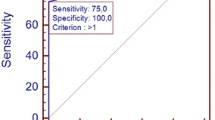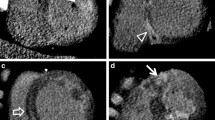Abstract
Aims: Contrast enhanced magnetic resonance imaging (ceMRI) has been shown to reliably identify irreversible myocardial injury. The aim of this study was to compare the findings on ceMRI with routine clinical markers of myocardial injury in patients with acute myocardial infarction (MI). Methods and results: Twenty-four patients with acute MI were investigated at 1.5 T. The global myocardial function was analysed with a standard cine MR protocol and a stack of short axis slices encompassing the entire left ventricle. Corresponding short axis slices were acquired for delayed ceMRI 15–20 min after the administration of 0.2 mmol gadolinium–DTPA/kg body weight. Mass of hyperenhancement and peak creatine kinase release (peak CK) was determined for each patient. The presenting 12-lead ECG was analysed for ST-elevation on admission and later development of Q-waves. Mass of hyperenhancement correlated moderately well to peak CK (r = 0.65, p < 0.01) and endsystolic volume index (r = 0.55, p < 0.01). Mass of hyperenhancement was inversely correlated to ejection fraction (r = −0.50, p = 0.02). Neither the presence of ST elevation on the admission ECG nor the later development of Q-waves did relate to the transmural extent of hyperenhancement and to the mass of hyperenhancement. Conclusion: Mass of hyperenhancement significantly correlates to global myocardial function and to peak CK. However, there is no relationship between the findings in ceMRI and 12-lead ECG abnormalities on admission suggesting an advantage of ceMRI in defining transmural extent and depicting small areas of necrosis.
Similar content being viewed by others
References
Mortality from coronary heart disease and acute myocardial infarction - United States, 1998. MMWR Morb Mortal Wkly Rep 2001; 50(6): 90–93.
Rude RE, Poole WK, Muller JE, et al. Electrocardiographic and clinical criteria for recognition of acute myocardial infarction based on analysis of 3697 patients. Am J Cardiol 1983; 52(8): 936–942.
Judd RM, Lugo-Olivieri CH, Arai M, et al. Physiological basis of myocardial contrast enhancement in fast magnetic resonance images of 2–day-old reperfused canine infarcts. Circulation 1995; 92(7): 1902–1910.
Kim RJ, Chen EL, Lima JA, Judd RM. Myocardial Gd-DTPA kinetics determine MRI contrast enhancement and reflect the extent and severity of myocardial injury after acute reperfused infarction. Circulation 1996; 94(12): 3318–3326.
Kim RJ, Fieno DS, Parrish TB, et al. Relationship of MRI delayed contrast enhancement to irreversible injury, infarct age, and contractile function. Circulation 1999; 100(19): 1992–2002.
Oshinski JN, Yang Z, Jones JR, Mata JF, French BA. Imaging time after Gd-DTPA injection is critical in using delayed enhancement to determine infarct size accurately with magnetic resonance imaging. Circulation 2001; 104(23): 2838–2842.
Sandstede JJ, Lipke C, Beer M, et al. Analysis of first-pass and delayed contrast-enhancement patterns of dysfunctional myocardium on MR imaging: use in the prediction of myocardial viability [see comments]. AJR Am J Roentgenol 2000; 174(6): 1737–1740.
Choi KM, Kim RJ, Gubernikoff G, Vargas JD, Parker M, Judd RM. Transmural extent of acute myocardial infarction predicts long-term improvement in contractile function. Circulation 2001; 104(10): 1101–1107.
Kim RJ, Wu E, Rafael A, et al. The use of contrast-enhanced magnetic resonance imaging to identify reversible myocardial dysfunction. N Engl J Med 2000; 343(20): 1445–1453.
Klein C, Nekolla SG, Bengel FM, et al. Assessment of myocardial viability with contrast-enhanced magnetic resonance imaging: comparison with positron emission tomography. Circulation 2002; 105(2): 162–167.
Wu KC, Rochitte CE, Lima JA. Magnetic resonance imaging in acute myocardial infarction. Curr Opin Cardiol 1999; 14(6): 480–484.
Kim RJ, Hillenbrand HB, Judd RM. Evaluation of myocardial viability by MRI. Herz 2000; 25(4): 417–430.
Pereira RS, Prato FS, Wisenberg G, Sykes J, Yvorchuk KJ. The use of Gd-DTPA as a marker of myocardial viability in reperfused acute myocardial infarction. Int J Cardiovasc Imaging 2001; 17(5): 395–404.
Feng YJ, Chen C, Fallon JT, et al. Comparison of cardiac troponin I, creatine kinase-MB, and myoglobin for detection of acute ischemic myocardial injury in a swine model. Am J Clin Pathol 1998; 110(1): 70–77.
Ishikawa Y, Saffitz JE, Mealman TL, Grace AM, Roberts R. Reversible myocardial ischemic injury is not associated with increased creatine kinase activity in plasma. Clin Chem 1997; 43(3): 467–475.
Heyndrickx GR, Amano J, Kenna T, et al. Creatine kinase release not associated with myocardial necrosis after short periods of coronary artery occlusion in conscious baboons. J Am Coll Cardiol 1985; 6(6): 1299–1303.
Piper HM, Schwartz P, Spahr R, Hutter JF, Spieckermann PG. Early enzyme release from myocardial cells is not due to irreversible cell damage. J Mol Cell Cardiol 1984; 16(4): 385–388.
Roe CR, Cobb FR, Starmer CF. The relationship between enzymatic and histologic estimates of the extent of myocardial infarction in conscious dogs with permanent coronary occlusion. Circulation 1977; 55(3): 438–449.
Ryan W, Karliner JS, Gilpin EA, Covell JW, DeLuca M, Ross J Jr. The creatine kinase curve area and peak creatine kinase after acute myocardial infarction: usefulness and limitations. Am Heart J 1981; 101(2): 162–168.
Wu AH, Ford L. Release of cardiac troponin in acute coronary syndromes: ischemia or necrosis? Clin Chim Acta 1999; 284(2): 161–174.
Kramer CM, Rogers WJ, Theobald TM, Power TP, Geskin G, Reichek N. Dissociation between changes in intramyocardial function and left ventricular volumes in the eight weeks after first anterior myocardial infarction. J Am Coll Cardiol 1997; 30(7): 1625–1632.
Irvin RG, Cobb FR. Relationship between epicardial ST-segment elevation, regional myocardial blood flow, and extent of myocardial infarction in awake dogs. Circulation 1977; 55(6): 825–832.
Adler Y, Zafrir N, Ben-Gal T, et al. Relation between evolutionary ST segment and T-wave direction and electrocardiographic prediction of mycardial infarct size and left ventricular function among patients with anterior wall Q-wave acute myocardial infarction who received reperfusion therapy. Am J Cardiol 2000; 85(8): 927–933.
Birnbaum Y, Maynard C, Wolfe S, et al. Terminal QRS distortion on admission is better than ST-segment measurements in predicting final infarct size and assessing the potential effect of thrombolytic therapy in anterior wall acute myocardial infarction. Am J Cardiol 1999; 84(5): 530–534.
Birnbaum Y, Criger DA, Wagner GS, et al. Prediction of the extent and severity of left ventricular dysfunction in anterior acute myocardial infarction by the admission electrocardiogram. Am Heart J 2001; 141(6): 915–924.
Birnbaum Y, Sclarovsky S. The grades of ischemia on the presenting electrocardiogram of patients with ST elevation acute myocardial infarction. J Electrocardiol 2001; 34: 17–26.
Birnbaum Y, Strasberg B. The predischarge electrocardiographic pattern in anterior acute myocardial infarction: relation between evolutionary ST segment and T-wave configuration and prediction of myocardial infarct size and left ventricular systolic function by the QRS Selvester score. J Electrocardiol 2000; 33: 73–80.
Dunn G. Design and Analysis of Reliability Studies. In: Design and Analysis of Reliability Studies. London: Edward Arnold, 1993.
Boden WE, Gibson RS, Schechtman KB, et al. ST segment shifts are poor predictors of subsequent Q wave evolution in acute myocardial infarction. A natural history study of early non-Q wave infarction. Circulation 1989; 79(3): 537–548.
Baer FM, Theissen P, Voth E, Schneider CA, Schicha H, Sechtem U. Morphologic correlate of pathologic Q waves as assessed by gradient-echo magnetic resonance imaging. Am J Cardiol 1994; 74(5): 430–434.
Antaloczy Z, Barcsak J, Magyar E. Correlation of electrocardiologic and pathologic findings in 100 cases of Q wave and non-Q wave myocardial infarction. J Electrocardiol 1988; 21(4): 331–335.
Wagner A, Mahrholdt H, Holly TA, et al. Contrast-enhanced MRI and routine single photon emission computed tomography (SPECT) perfusion imaging for detection of subendocardial myocardial infarcts: an imaging study. Lancet 2003; 361(9355): 374–379.
Kwong RY, Schussheim AE, Rekhraj S, et al. Detecting acute coronary syndrome in the emergency department with cardiac magnetic resonance imaging. Circulation 2003; 107(4): 531–537.
Wu E, Judd RM, Vargas JD, Klocke FJ, Bonow RO, Kim RJ. Visualisation of presence, location, and transmural extent of healed Q-wave and non-Q-wave myocardial infarction. Lancet 2001; 357(9249): 21–28.
White HD, Norris RM, Brown MA, Brandt PW, Whitlock RM, Wild CJ. Left ventricular end-systolic volume as the major determinant of survival after recovery from myocardial infarction. Circulation 1987; 76(1): 44–51.
Author information
Authors and Affiliations
Rights and permissions
About this article
Cite this article
Petersen, S.E., Horstick, G., Voigtländer, T. et al. Diagnostic value of routine clinical parameters in acute myocardial infarction: a comparison to delayed contrast enhanced magnetic resonance imaging. Int J Cardiovasc Imaging 19, 409–416 (2003). https://doi.org/10.1023/A:1025856816168
Issue Date:
DOI: https://doi.org/10.1023/A:1025856816168




